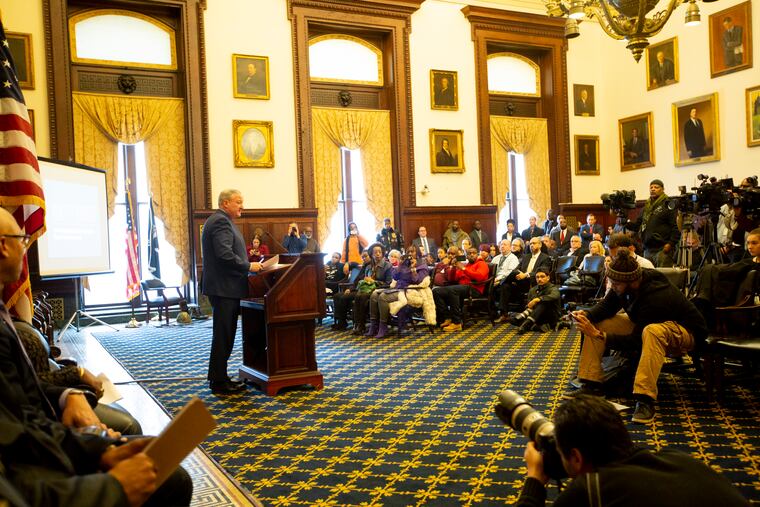Can Philadelphia stop the bloodshed? Here’s where Kenney’s latest plan could help | Editorial
Mayor Kenney’s plan is the most comprehensive in recent memory but also painfully long overdue.

By the time Mayor Jim Kenney announced a sweeping antiviolence strategy Thursday, there were already nine homicides on the books for 2019, a 29 percent hike over the same time last year.
The ninth death happened on Tuesday. Police found a man in his 20s with two gunshots to his head and several to his chest in Fairhill. Gun violence doesn’t only take lives. It robs us of a sense of security, just as it did in East Germantown on Jan. 13. Four men were caught on video shooting at an unidentified victim there. After daybreak, residents called police to complain about bullet holes in their houses.
The increasing violence is part of a deeply disturbing trend. Last year, there were 351 homicides — the most since 2007, when there were 391. This is happening at the same time other major cities are seeing a decline in gun violence.
Kenney’s plan — the result of his entire cabinet working together since September — is the most comprehensive in recent memory, but also long overdue. He wants to draw on the city’s police and social service agencies to fight this complex epidemic as the public health crisis it is. It allocates $4 million from this year’s budget.
Kenney calls for enhanced police tactics, like data-driven crime analysis and installing more gunshot detectors that can help police. He wants the city to identify people at risk of becoming assailants, victims, or both, and help them deal with trauma. Kenney also said the city would increase blight reduction programs and help ease the transition for those released from prison.
Beyond making city agencies work together to attack the complex root causes and results of violence, Kenney wants to enlist the help of the School District, employers, and community groups.
Many from those groups attended Kenney’s announcement in a show of support, as did members of City Council and School Superintendent William R. Hite Jr. Noticeably absent was District Attorney Larry Krasner, whose office said he had a scheduling conflict. His participation is essential to the success of Kenney’s initiative. For example, several years ago, police, social service agencies, and the former District Attorney implemented a “focused deterrence” program. It targeted gang members and deterred troublemakers with increased sentences and helped others find jobs. According to a Temple University analysis, the program reduced crime in South Philadelphia by 35 percent between 2013 and 2015. But it hasn’t been fully operational for a while, and Kenney’s plan makes no mention of whether it would be modified or expanded.
Police Commissioner Richard Ross said he’d like to expand the program. Krasner’s office said he’s having “an ongoing conversation” to tweak it. Krasner should wrap up that conversation soon, because a program that reduced crime by 35 percent shouldn’t have to wait any longer to get back up to speed.
Kenney should remain open to changing up tactics, such as keeping the public informed — not a typical strength of city government. He plans to make periodic reports via a web page. The public can then make its own evaluations and hold city officials accountable for stopping the bloodshed.